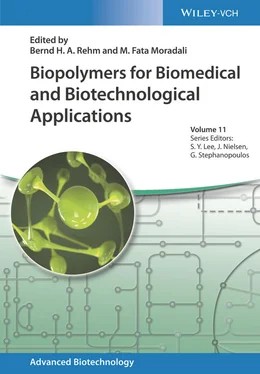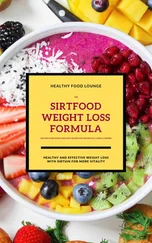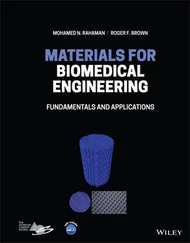Biopolymers for Biomedical and Biotechnological Applications
Здесь есть возможность читать онлайн «Biopolymers for Biomedical and Biotechnological Applications» — ознакомительный отрывок электронной книги совершенно бесплатно, а после прочтения отрывка купить полную версию. В некоторых случаях можно слушать аудио, скачать через торрент в формате fb2 и присутствует краткое содержание. Жанр: unrecognised, на английском языке. Описание произведения, (предисловие) а так же отзывы посетителей доступны на портале библиотеки ЛибКат.
- Название:Biopolymers for Biomedical and Biotechnological Applications
- Автор:
- Жанр:
- Год:неизвестен
- ISBN:нет данных
- Рейтинг книги:5 / 5. Голосов: 1
-
Избранное:Добавить в избранное
- Отзывы:
-
Ваша оценка:
- 100
- 1
- 2
- 3
- 4
- 5
Biopolymers for Biomedical and Biotechnological Applications: краткое содержание, описание и аннотация
Предлагаем к чтению аннотацию, описание, краткое содержание или предисловие (зависит от того, что написал сам автор книги «Biopolymers for Biomedical and Biotechnological Applications»). Если вы не нашли необходимую информацию о книге — напишите в комментариях, мы постараемся отыскать её.
Biopolymers for Biomedical and Biotechnological Applications — читать онлайн ознакомительный отрывок
Ниже представлен текст книги, разбитый по страницам. Система сохранения места последней прочитанной страницы, позволяет с удобством читать онлайн бесплатно книгу «Biopolymers for Biomedical and Biotechnological Applications», без необходимости каждый раз заново искать на чём Вы остановились. Поставьте закладку, и сможете в любой момент перейти на страницу, на которой закончили чтение.
Интервал:
Закладка:
2.3.2 Scleroglucan
Scleroglucan is a water‐soluble homopolymer of β‐glucans produced by filamentous fungi, especially of the genus Sclerotium as part of the adhesion mechanism to plant tissues [16,88]. Scleroglucan was first commercialized in the 1970s, being currently available under different trademarks (e.g. Clearogel, Polytetran, Polytran FS, Actigum) [88,89].
Scleroglucan is a thermostable biopolymer and, due to its nonionic nature, is stable over a wide range of pH (2.5–12). Scleroglucan solution exhibits shear thinning behavior; it acts as foam stabilizer and has a good emulsifying capacity. Further, it also exhibits biological activity. The interesting physicochemical and biological properties enable the use of scleroglucan on several industrial applications. Initially, scleroglucan was used in the oil industry [90,91]. Nowadays it is used as thickener in paintings and in pesticides [16]. In the biomedical field it is used in edible films, tablets, and granulates, showing to be a good matrix for the controlled release of active substances. Pharmaceutical applications include the use in tablet coatings, ophthalmic solutions, injectable antibiotic suspensions, and calamine lotion [92]. In the food industry scleroglucan is used for the stabilization of dressings and ice creams. Numerous patents describe quality improvement of frozen or heat‐treated edibles. In Europe it is mainly used in cosmetic products for the skin, such as body washes, shampoos, conditioners, and eyeliners [16,93,94].
2.3.3 Xanthan Gum
Xanthan gum is a heteropolysaccharide isolated from Xanthomonas campestris composed of a 1,4‐β‐D‐glucose backbone having a trisaccharide side chain (a glucuronic acid residue between two mannose residues) attached to alternate glucose residues [95,96]. It forms highly viscous aqueous solutions, even at low concentrations, with shear thinning behavior, and is stable in terms of temperature, salts, and a wide range of pH. It is the most widely accepted commercial bacterial polysaccharide due to its exceptional rheological properties [7,95,97]. Xanthan's major commercial producers comprise CP Kelco, Merck, Pfizer, Rhône‐Poulenc, Sanofi‐Elf, and Jungbunzlauer. It is used in several industries, such as foods, food packaging, personal care products, cosmetics, drug delivery systems, water treatments, and drilling fluids [12,98].
Recent trends on the use of xanthan‐based polysaccharide are focused on the use of formulations for various tissue engineering applications. Moreover, the shear thinning and gelling properties of xanthan are interesting in the area of 3D bioprinting of the tissue scaffolds and/or tissue models for future tissue engineering applications [12,98]. The use of xanthan in the form of luminescent composites, namely, nanocrystals, for biomedical applications shows good potential but is barely explored [98]. Xanthan‐based polymers have also been studied for solid polymeric electrolytes [99,100].
2.3.4 Dextrans
Dextrans are homopolysaccharides composed of D‐glucose units. Species belonging to the genera Leuconostoc , Weissella , Lactobacillus , Pediococcus , and Streptococcus produced dextran [101,102]. Dextrans have interesting physicochemical properties, such as thickening capacity, emulsifier or stabilizing ability, and high solubility in water. Additionally, its flexible structure is an important characteristic that enables the dextran use as functional hydrocolloid. Dextran is used as thickening agent in cosmetics and foods (e.g. bakery products and confectionery) to improve texture and moisture and prevent sugar crystallization. It is also used in pharmaceutical/biomedicine applications and formerly was applied for drug delivery and blood plasma polymer expander [7,103]. The potential of dextran‐based polymers is being evaluated to form nanofibers for controlled drug release [104], as anticancer therapeutics [105,106], and as hydrogels for wound healing [107]. Dextran is commercialized by some companies, such as Oregon Green and ATTO‐TEC.
2.3.5 Curdlan
Curdlan is a glucan produced by Alcaligenes , Rhizobium , and Bacillus species. It is alkaline‐soluble and water‐insoluble gel‐forming polymer, which limits its industrial applications [108,110]. Hence, curdlan has traditionally been used as a stabilizer, texturizer, and thickener in the food industry [111,112].
Further, some studies showed interest in converting curdlan into more soluble oligosaccharides, exhibiting notable biomedical functions (e.g. antitumor and immunological activities) [113,114]. Besides, the oligosaccharides may also have an efficient role in the improvement for sustainable agriculture since it can efficiently activate the plant innate immune defense system [115]. Research on curdlan and its derivatives are being performed to develop environmentally friendly alternatives to oil‐based plastics [111].
2.3.6 Gellan Gum
Industrially, gellan gum is produced by the bacterium Sphingomonas paucimobilis ATCC 31461 [116]. It is a heteropolysaccharide composed of L‐rhamnose, D‐glucose, D‐glucuronic acid, and D‐glucose monomers and side chains of acetyl and glyceryl substituents. Gellan gum have the ability to form gels, whose properties are dependent on the acyl group content: low acyl form produces rigid, nonelastic, brittle, and thermostable gels, while the high acyl gellan produces soft, elastic, non‐brittle, thermoreversible gels [117,118]. Gellan gum is mainly used in the food industry, namely, as a thickener, stabilizer, and binder agent. It is used in desserts and drinking jellies, as well as in low‐calorie (sugar‐free) jams, fruit preparations, yogurt, sauces, nonfat salad dressings, and films [119,120]. Gellan gum is commercialized as Kelcogel, a gelling agent in the food industry, and is marketed by CP Kelco.
Moreover, gellan is described as a multifunctional additive for various pharmaceutical products, especially for controlled release forms, including oral, ophthalmic, nasal, and other formulations [121,122]. It is already used in ophthalmic formulations (e.g. Timoptol). Recent reports suggest that gellan‐based materials can also be used in tissue engineering, regenerative engineering, or gene transfer technology [118,123,124].
2.3.7 Levan
Levan is a homofructan composed of fructose residues and can be secreted by several microorganisms (e.g. Acetobacter sp., Halomonas sp., Zymomonas sp., Lactobacillus sp.) or produced by plants [7,125,126]. Levan does not swell in water, and it has a very low intrinsic viscosity value. It is water and oil soluble, is compatible with salts and surfactants, and has emulsifying capacity, biological activity, and adhesive ability [127,128]. Its functional properties turn it suitable for use in food (e.g. prebiotic agent), cosmetics (e.g. dermal filler), and pharmaceuticals. The levan low viscosity promotes its use in pharmaceuticals to produce capsules or coatings and in several therapeutic applications. Levan nanoparticles have potential to delivery peptides and protein drugs. Further, levan is used in the green synthesis of silver and gold nanoparticles [126,129]. It is produced by Montana Polysaccharides Corp. in the United States.
2.3.8 Hyaluronic Acid
Hyaluronic acid (HA) is a linear polymer composed of repeating disaccharide units of glucuronic acid and N ‐acetylglucosamine [130,131]. It is produced by S. zooepidemicus ; however the concern about the pathogenicity of Streptococcus has driven the efforts toward transforming generally recognized as safe (GRAS) nonproducers (e.g. Lactococcus lactis , Bacillus subtilis ) into HA producers [130]. HA shows a great swelling capacity, biocompatibility, non‐immunogenicity, biodegradability, and viscoelasticity. Its physicochemical and biological properties render HA potential for applications in cosmetics (e.g. dermal filler), pharmaceuticals, and medicine (e.g. osteoarthritis treatment, tissue engineering) [132,134]. Ongoing research on HA and its numerous modifications/blends shows the development of materials with improved properties for drug delivery and tissue engineering technologies [135,136].
Читать дальшеИнтервал:
Закладка:
Похожие книги на «Biopolymers for Biomedical and Biotechnological Applications»
Представляем Вашему вниманию похожие книги на «Biopolymers for Biomedical and Biotechnological Applications» списком для выбора. Мы отобрали схожую по названию и смыслу литературу в надежде предоставить читателям больше вариантов отыскать новые, интересные, ещё непрочитанные произведения.
Обсуждение, отзывы о книге «Biopolymers for Biomedical and Biotechnological Applications» и просто собственные мнения читателей. Оставьте ваши комментарии, напишите, что Вы думаете о произведении, его смысле или главных героях. Укажите что конкретно понравилось, а что нет, и почему Вы так считаете.












